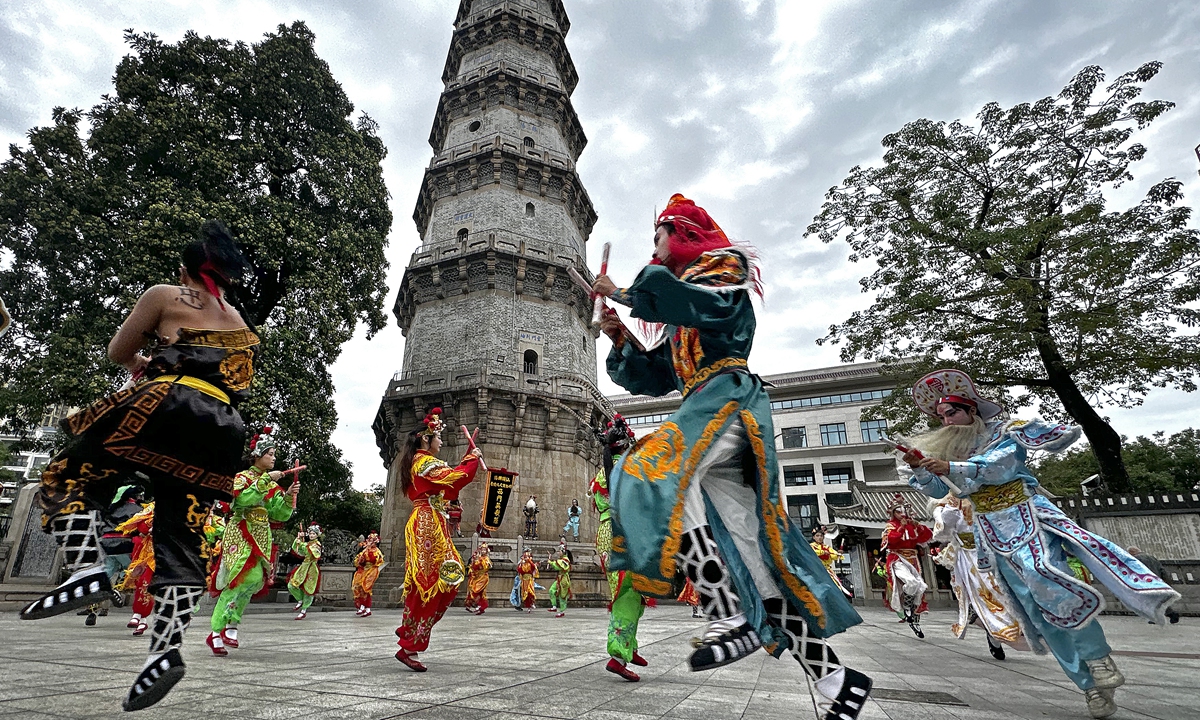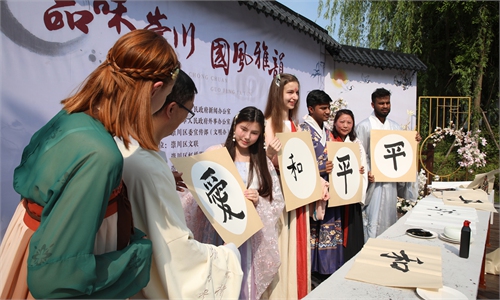
Yingge dancers perform at an ancient tower in Shantou city
Editor's Note:
"China in Photos" is a series featuring foreign photographers who have explored China through their lenses. With cameras and curiosity, they capture the country's landscapes and people, revealing a China that is raw, intimate and deeply human. Each interview offers a unique perspective on China's diversity. Join us as we see China through their eyes.
In the second article of this series, Global Times (GT) reporter Su Yaxuan interviewed US photographer Michael Nelson (Nelson). At the beginning of this year, Nelson embarked on a creative field trip to Guangdong Province. "Take a chance with China. You will be rewarded and have a memorable experience," he said.
GT: What typically caught your eye in Guangdong and made you want to capture it through your lens?
Nelson: One of the most fascinating aspects of my trip to Guangdong was the incredible contrast between tradition and modernity.
Our journey began in the villages of the Yao ethnic minority in the mountains. The landscape was breathtaking - rolling peaks with unusual shapes, pristine nature, and no visible traces of modern life, such as advertisements or urban infrastructure. The area we visited was still inhabited, preserving a traditional way of life. Many locals wore traditional clothing.
Then, we traveled to major cities, including Guangzhou, Foshan and Shenzhen, where the modernity was staggering. Guangzhou's architecture left a deep impression on me: towering skyscrapers, dazzling light displays along the river, and the iconic Canton Tower illuminated with lasers and color-changing lights.
Even within Guangzhou itself, the contrasts were striking. In Shantou's old town, we saw people living an old-style urban life - playing games, selling tea, watching TV and riding bicycles. Just nearby, however, were modern tech centers featuring AI and robots, showcasing Guangdong's rapid advancement.
Overall, Guangdong offered an unforgettable mix of past and future, where ancient traditions coexist with rapid technological progress.
GT: Could you share some particular moments that, in your view, most vividly encapsulate the essence of Lingnan culture (also known as Cantonese culture)?
Nelson: The Yingge Dancers in Shantou incorporated so much of what I found fascinating about Lingnan culture. Here you had these amazing outfits, face paintings and dance moves. The atmosphere was joyous and exuberant. It demonstrated to me the immense pride and honor these young people have in keeping their old traditions and culture alive.
That day, after dinner, the Yao villagers put on a show for us. I thought we'd just sit and watch, but no. We lit this huge bonfire, then danced around it with our torches. Then they asked my colleague and me if we wanted to dress in Yao outfits - of course we said yes! So we changed into Yao costumes and danced with them.
The next day brought another cultural challenge. At a restaurant, some women dressed in traditional clothes had us drink rice wine from special containers where it cascades down. You have to drink it continuously for about two minutes! These experiences - the spontaneous Yingge dancing and the Yao village celebrations - really capture the living traditions of Lingnan culture.
GT: Many of your photos feature people as the main subject. Could you introduce one image that carries a powerful story? What aspects of Lingnan culture or Chinese society does it reflect?
Nelson: One of my most memorable photos captures a master sculptor in Foshan. In his studio, his life's work surrounded him. Having practiced his craft for over 60 years, his studio was filled with incredible pieces.
When I mentioned through a translator that my son was also an artist who loved Eastern mythology, he generously gifted us a signed monograph of his book, inscribing a personal message for my son. This spontaneous act of kindness perfectly embodied the Chinese values of cultural transmission.
My eye was particularly drawn to one distinctive piece in his collection. "This one is different," I remarked. The sculptor proudly explained it was his daughter's creation, his voice swelling with pride. This revelation added profound depth to the sculpture, showcasing the living continuity of Chinese cultural heritage.
This encounter reflects the essence of what makes Chinese craftsmanship so special: the decades of dedication, the passing of skills through generations and the living connection between ancient traditions and contemporary creativity. The sculptor wasn't just preserving the past; he was actively shaping the future of his art form.
GT: You described this trip as an "adventure" in your travel journal. Why did you choose that word to sum up your experience?
Nelson: For me, an adventure implies new experiences, new places, new people, new cultures, new histories and traditions, and Guangdong Province was all of those things at every turn.
Let me give you some concrete examples. When I landed at Guangzhou airport coming from Cairo, the contrast was striking. Both are mega-cities about 20 million people, but Guangzhou was orderly and clean.
Moreover, I cleared passport control without stopping! This smooth operation was my first taste of China's famous organizational skills. I'd seen it before in Shanghai eight years ago, and again in Sichuan just before this trip, but it still impressed me.
Another fresh discovery was the health culture. Unlike the US' obesity problems, Chinese people generally appear fit. They walk in parks, do Tai Chi - it's clear that health is a top priority, whether through personal choice or government initiatives.
And contrary to stereotypes about restrictions, I've always found freedom to explore in China. This time, while we often had guides, it was primarily for translation and companionship. We became genuine friends with our local hosts.
From the high-tech airports to the electric scooters, from the ancient traditions to modern efficiency. Every trip to China reveals new layers. The vibrant street life, the mix of ancient and modern, the warmth of the people - all of it feels fresh each time.
GT: You also shared this journey with American university students. How did this make you feel? What kind of feedback did you receive from them?
Nelson: We shared our experiences not only with university students but also with visitors to the exhibition. I loved telling everyone about my experiences and the places and people I had seen and met. Their feedback was super enthusiastic, and many of them expressed how surprised they were to see how China looked. Many said that after the exhibits and presentations, they felt more comfortable and enthusiastic about making a trip to China one day.
GT: As a foreigner in China, compared with Chinese photographers, what do you think is the unique value or perspective that your documentary photography brings to understanding China?
Nelson: Having observed the work of many Chinese photographers, I've noticed a distinct difference in our perspectives.
What makes my perspective different is that I'm fascinated by everyday street life - how people live, the small moments that feel unique to me.
I love capturing ordinary life, such as people walking dogs, street dancing, playing games, and gathering in public spaces. These unremarkable moments reveal so much about real life, but the locals might overlook them precisely because they are normal.
China is an incredible place. Like many places on Earth, it has its own unique life, culture, history, geography, and so much more. It is easy to get around and very welcoming. The diversity and contrasts are amazing.
To people around the world, I'd say "Take a chance with China. You will be rewarded and have a memorable experience."



